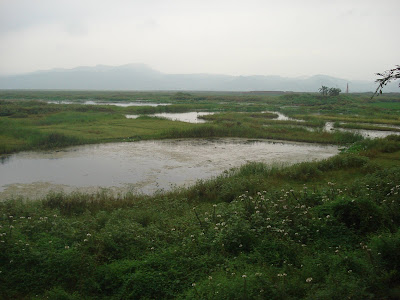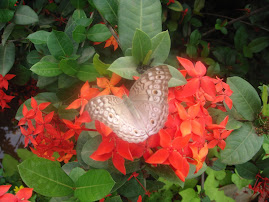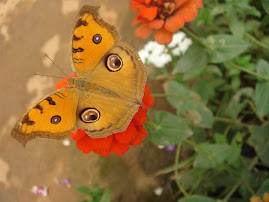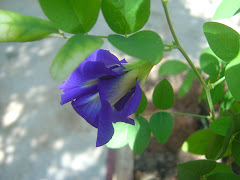


The largest and most important wetland in the Brahmaputra
Valley in lower Assam is Deepor Beel. The word 'beel'
means pond in Assamese. Situated to the south-west of the
city of Guwahati, it is a former channel of the river
Brahmaputra and is a haven for the region's rich diversity
of flora and fauna.

Deepor Beel was designated a Ramsar site in November 2002.
The Ramsar convention is an international treaty for the
conservation and sustainable utilization of wetlands. This
is to stem the encroachment and loss of wetlands now and in
future; recognizing the fundamental ecological functions of
wetlands and their economic, cultural, scientific, and
recreational value. The Convention is named after a town in
Iran.

Around this time the most eye-catching blooms on the fringes
of beels in Assam are these Spider flowers. The pink varieties
grow in abundance at Pobitora Wildlife Sanctuary, best known
for its rhino population. I had taken these two photos back in
January. A little digression to show the difference in colour.


The Spider flowers at Deepor Beel are of the white/purple
variety.

A long stretch of more Spider flowers. Deepor Beel has many
species of aquatic grasses, water lilies and water-hyacinth.
The WWF site has a detailed list of aquatic plants found in
the area.

219 bird species has been recorded here of which 70 species
are waterfowl. There are 50 species of fish as well as
amphibians, lizards, snakes, turtle and tortoise species.
Some of the birds seen here are grey-headed lapwing, ruddy
shelduck, red-crested pochard, lesser and greater adjutant
stork, black-necked stork, large whistling teal, cormorants,
spot-billed pelican and aeriel predators.
Winter is the best time for bird-watching as migratory birds
come here in thousands.

Tough-looking grass on the banks.


A blurry picture of birds.
Wetlands are one of the world's most threatened ecosystems.
More than half have been destroyed. Some have disappeared
due to natural causes but many have been destroyed by
humans. Encroachment and pollution, industries near the
banks, killing of birds and other animals are major setbacks.
Once the total area of Deepor Beel was 41 kms. but now it is
only 4.14 sq. kms. But it is heartening to note that local
green organisations are coming forward to help save Deepor
Beel so that it will remain a haven for all the life that
it supports. And for nature lovers as well.











































.jpg)

































16 comments:
How interesting to read about your wetlands and efforts being made to protect them. Such a wide variety of plants and birds, many of which I am not familiar with. Thank you for sharing a part of your world today Kanak.
Kanak,
Lovely wetland and I'm glad they are taking the right steps to save it. Look what we did to the Everglades, it will never recover.
The spider flowers looks like a plant we have here, very invasive.
It is very important to protect this wetland and it is good organizations are doing so. To have it shrink to only 10% of its original area is quite a bit. We have the same problem here with our everglades. A long term solution and problem for sure. Those spider flowers are pretty neat.
A resource we need to preserve for future generations of wildlife and plants indeed. :)
Wow what a beautiful area Kanak! I'm glad to hear there are organizations trying to save areas like this. Leave it to us humans to destroy ecosystems such as this.
Thanks for showing us the beauty of it.
Kanak it is beautiful out there! You really do live in a paradise! Good thing that the wetlands are now protected. In my country we have one area that is a nature sanctuary and now it has closed due to lack of funds. The government is very slow in finding a solution or buying it over. Many many beautiful places are lost due to the lack of foresight by government officials as well as those in the private sector. I am enjoying your country through your eyes, lovely post!
Hi Kanak, this is one interesting wetland. The flowers are all in purple shades? The spider flower is so unique and beautiful. I see that the birds are loving the place. Nice post ;-)
Wow!Amazingly beautifull!
Hey Kanak, the Spider flowers are really beautiful and just wanted to say thanks for the inspiration...
Mildred, there are many low-lying (small) areas dotting the city. And it's always interesting to see how the seasons bring the changes--in blooms and wildlife activity. But Deepor Beel is special!
Randy/Tina, how similar the threats are to wetlands all across the world. I just hope that the conservation efforts succeed to a great extent.
Racquel/Susie, here's hoping that no more portion of this beautiful piece disappears in the name of development!
Helen, thanks. Protection in many sanctuaries isn't total. We do read about tortoises being caught and birds being shot. But at least efforts are on. Reading all the comments here makes me want to show the beauty of the region that I'm most familiar with. Thank you for your words about my country...I feel so proud!
Stephanie, hmmm... now that you've mentioned it, I remember that I haven't posted the pic of a flowering shrub in the area. The blooms? The colour purple!! Strange, isn't it?
The spider flower looks beautiful but it also has an unpleasant smell. But bees and butterflies think otherwise!!
Linda, thank you so much!
Ruby/Arun, SO glad you've started your blog. And what a pleasure it is to see your great photography!
Thank you for sharing that beautiful part of the world with us.
I grow several carnivorous plants and know how important it is to protect wetland areas worldwide. As the wetlands disappear, so does the life that it supports. We should all do our part to raise awareness about these ecosystems.
Deepor Beel is cool. But it has been reduced to just 10 per cent of its original area? How shocking! And, shameful. Apart from the factors you mention, the water hyacinth (shown in your first pic) is also highly invasive. I know of a beautiful lake in Mysore which was almost destroyed by the plant but now thankfully saved.
My pleasure, Sue.
Prospero, I'm now into reading about threats to wetlands worldwide. It seems to be almost the same in many areas--it's just that the magnitude is either
greater or lesser.
It is, Shailaja. When I was clicking away that was the thought on my mind. Beautiful and yet so harmful. I hope when weeds are cleared next time, these will also be removed.
Dear Kanak, it is, as always, a pleasure to come in here to see your wonderful pictures and read your posts.These pictures of Deepor Beel gives me a rush inwards... Its open spaces ( whatever is left of it ) and the varied eco system that sustains in there despite the throttling surroundings, is itself a reflection of how fragile our own existance is...
As one leaves the madness of our city, the refreshing sight and smell of that area calls out for us to ponder and try to make some difference...
You are doing your bit Kanak, and I am so happy that through your love for nature and passion for such issues, you are making that difference... Salute!! :-)
Sano, I'm so touched by your words...I'm glad that I stopped and spent some time there. I'd always wanted to do it but never got around to doing it. Blogging has helped me to follow my heart in ways I didn't even dream of...I'll explain when we meet next.
About the throttling surroundings and about how fragile our own existence is--that's so well put. We can see the replication of harming our surroundings in every little water body that almost all neighbourhoods have.
But to pass by Deepor Beel is to also hope and be thankful that we still have that much of wetland left. And blooms, and birds.
Post a Comment